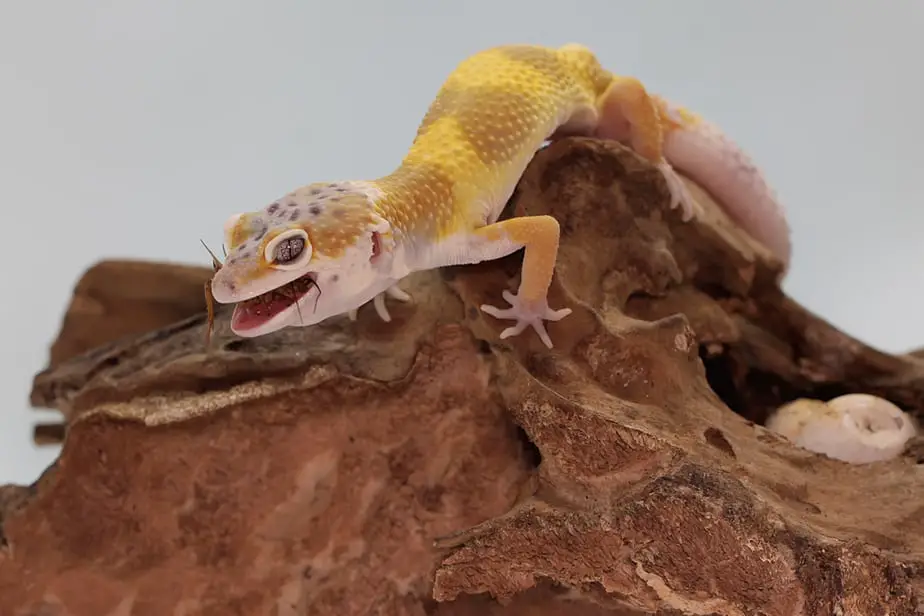Adding diversity to your leopard gecko’s diet is always a good idea. This provides your leopard gecko with all the nutrients they need and helps them improve their hunting skills. But can leopard geckos eat grasshoppers?
Yes, leopard geckos can eat grasshoppers. These insects aren’t toxic to them. In fact, they can provide them with much-needed protein and add some flavor to their diet. Ultimately, leopard geckos love grasshoppers and can eat them two or three times a week.

What are the benefits of feeding your leopard gecko grasshoppers?
Grasshoppers are great for leopard geckos for a variety of reasons. These include:
Grasshoppers are full of nutrients
If there’s one thing that grasshoppers have going for them, it’s an impressive nutritional profile. In fact, they are so nutritious that some humans eat them. Generally, they have a higher percentage of protein and fiber than both crickets and mealworms. Also, they have almost the same moisture content as crickets and mealworms.
Locusts are an exceptionally nutritious species of grasshopper. They have a higher percentage of protein and fat than other grasshoppers. What’s more? They have a calcium to phosphorus ratio of 1:6 – a bit higher than crickets and mealworms. This means that they can help reduce your gecko’s chances of getting metabolic bone disease.
Be careful not to overfeed grasshoppers to your leopard gecko, though. While excessive fiber ingestion can lead to digestion issues, excessive fat ingestion can contribute to obesity.
Grasshoppers can help stimulate your leopard gecko
If there’s one thing we all know about grasshoppers, they are active, fast, and difficult to catch. Moreover, the hind legs of grasshoppers are powerful, allowing them to jump up to 50cm high. As such, these insects can be exciting prey for leopard geckos, especially for those who are young and active
Ultimately, grasshoppers can stimulate the bodies and minds of such geckos, preventing boredom, weight gain, lethargy, and struggles with mental health. In husbandry, introducing new prey and experiences to your leopard gecko is considered environmental enrichment. Ultimately, environmental enrichment can help animals in captivity express their natural behaviors.
When using prey for this purpose, though, make sure that it’s alive – it’s the only way this works. If you notice that your leopard gecko is struggling to catch grasshoppers, you can slow them down for it. Place the grasshoppers in the refrigerator for ten minutes before you offer them to your leopard gecko.
What are the challenges associated with feeding grasshoppers to your leopard gecko?
While offering grasshoppers to leopard geckos has its advantages, it also comes with its cons. These include:
Grasshoppers can be too large for some leopard geckos
One thing you should know about grasshoppers that are sold as feeder insects it’s that they grow really big. So when you don’t use them quickly, they can get too large for your leopard gecko to handle. Locusts can grow even to be 7cm in width. This can be difficult for even adult leopard geckos.
Grasshoppers aren’t available as feeder insects in the USA
If you live in the USA, it’s impossible to buy grasshoppers to use as feeder insects – it’s illegal to breed and sell grasshoppers in the country. This ban was put in place because most of the grasshoppers available in Europe and the Americas are of the locust species. And some locusts can be dangerous and destructive. They can destroy tons of crops when they swarm, damaging both the environment and the economy.
So if you live in the US and want to feed grasshoppers to your leopard gecko, you’ll have to get them from the wild or opt for freeze-dried ones. You can also feed them freeze-dried crickets.
Grasshoppers are expensive
Even when you live outside of the US, buying grasshoppers isn’t easy – they are more expensive than crickets and other alternatives. So if you want to offer them to your leopard gecko regularly, the costs may be too much for you.
Wild grasshoppers pose some risks
Since grasshoppers naturally live in many fields and gardens, it’s easy to catch some and feed them to your leopard gecko. However, this comes with some risks. For one, wild grasshoppers are exposed to a lot of pathogens/parasites and are more likely to carry diseases than those bred in captivity. While these could not be making the grasshoppers sick, they could make your leopard gecko sick.
Some grasshoppers are exposed to chemicals that can harm your leopard gecko. This is particularly common with locusts – since they are considered pests, many people spray insecticides and pesticides on them. And since they tend to spend a lot of time on crops and agricultural land, they can be exposed to fertilizers.
Freeze-dried grasshoppers can make your leopard gecko impacted
Available online and in pet shops, freeze-dried grasshoppers are considered a good option by many leopard gecko keepers. However, these grasshoppers usually have a low moisture content due to the dehydrating nature of the freeze-drying process. So if you regularly feed your leopard gecko a lot of freeze-dried grasshoppers, they can easily get impacted.
Since impaction can be fatal, it’s best to avoid it. So if you want to feed freeze-dried grasshoppers to your leopard gecko, offer them as treats or in case of emergency.
How to feed your leopard gecko grasshoppers
There are two key things to consider when offering grasshoppers to leopard geckos: the grasshoppers’ size and quantity. Ideally, you should only offer 5 to 8 grasshoppers per meal to your leopard gecko. Also, never feed your leopard gecko a grasshopper larger than 34mm.
Conclusion
While leopard geckos can eat grasshoppers, these insects are expensive and can be hard to find. As such, they should serve as a treat rather than the main ingredient of your leopard gecko’s diet.
